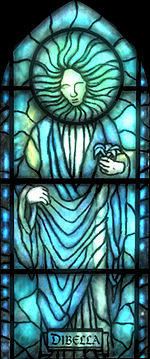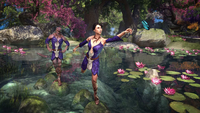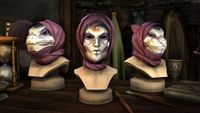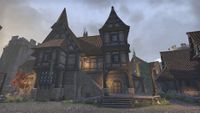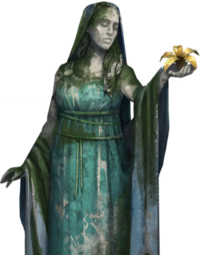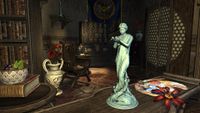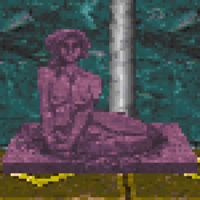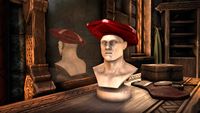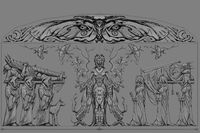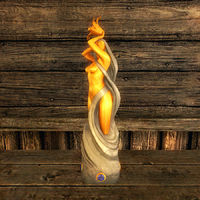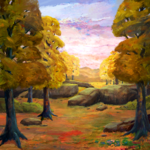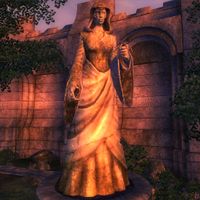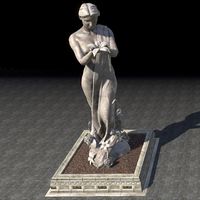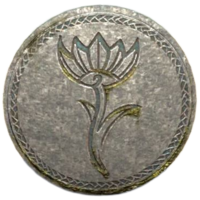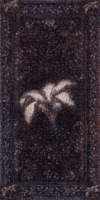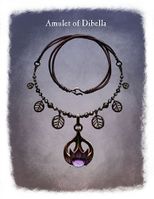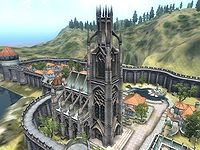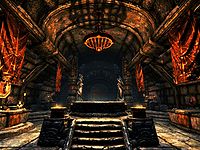Lore:Dibella
- Come to me, Dibella, for without you, my words must lie dull and leaden without the gilding of grace and sagacity to enchant the reader's ear and eye. — Pocket Guide to the Empire, 3rd Edition
Dibella, also known as the Passion Dancer,[1] Our Blessed Lady,[1] and simply, the Lady,[1] is the Goddess of Beauty,[2] Love,[3] and Affection.[1] She is also acclaimed as the Lady of Love,[4] Beauty, Art, and Music.[1] Dibella is the Queen of Heaven,[5] and is one of the Divines.[6]
Contents
Mythology[edit]
According to the creation myth presented in the Anuad, Dibella and the aedra (gods) were born from the mingled blood of Anu and Padomay, the good and evil primal forces, respectively, and therefore have a capacity for both good and evil, in contrast to the daedra, who were born solely from the blood of Padomay.[7] The formation of Akatosh, the God of Time, from the mingled blood of the brothers Anu and Padomay facilitated the formation of Dibella and the gods as they learnt to structure themselves.[8] Shezarr's Song, a Cyrodiilic creation myth, acclaims the creation of Mundus to the sacrifice of Dibella and the gods whose sacrifices were embodied as eponymous planets.[9][10] Dibella and the gods were subsequently bound to the Earth Bones as a result.[9] Followers of the cult known as the Mythic Dawn deem Dibella and other gods as false gods and claim she and others betrayed Lorkhan.[11]
Teachings[edit]
Dibella, as Goddess of Beauty, is the embodiment of beauty and teaches mortals to seek truth through beauty and worship.[12] Those who follow the teachings of Dibella, and propagate beauty and promote harmony, are granted charm and grace.[12] The Goddess teaches that mortals should give themselves to love,[13] and commands them to open their hearts to "the noble secrets of art and love. Treasure the gifts of friendship. Seek joy and inspiration in the mysteries of love".[14] Dibella holds no limit on the number of lovers one may have, but demands focus on the quality of the essence of love, not the quantity.[1] She teaches that, "No matter the seed, if the shoot is nurtured with love, will not the flower be beautiful?", and blesses the love of those which is pure and untainted.[1]
Dibella discourages relations with undead, such as vampires, and concurs with the teachings of Arkay that vampires have impure spirits.[1] Dibella is known as the Divine who "pays Men in Moans".[15] Critics of Dibella consider her a lustful and passionate goddess.[16][17]
Worship[edit]
Dibella and her worshippers are argued to have what can be considered a personal relationship, in contrast to the formal and impersonal relationship held by the worshippers of other Divines.[18]
A number of cults dedicated to Dibella can be found in Cyrodiil, High Rock, Hammerfell and Skyrim, and are varied in their focus.[19] Some cults of Dibella focus on women, artists or aesthetics, while others concentrate on erotic instruction.[19] The latter have been known to bestow a Mark of Dibella upon those on whom they have practiced their "Dibellan Arts".[20][21] When worshipers of Dibella wish to honor the Lady of Love by engaging in anonymous bestowal of affection, they don a porcelain Dibella's doll mask.[22]
The Goddess makes her will known to mortals through her sybil, who is revealed to her priesthood via the ceremony known as the Exalted Protocol of the Dibellan Sybil[23] The ceremony is known only to the priesthood of Dibella, and is kept secret from the general population, including acolytes of other Divines.[24] The newly-chosen sybil may be a child, who would then leave her parents to live in the temple.[25]
A House of Dibella will typically have three or four white cats within, as they are sacred to the goddess.[26]
Worship in Black Marsh[edit]
The majority of the population of the province of Black Marsh venerate the Hist, and, in the Second Era, worship among the Argonians of Black Marsh of Dibella and the gods was limited to a small minority of those who had assimilated to the culture of the Empire.[27]
The Kothringi, the indigenous humans of Black Marsh, are known to have worshipped Dibella.[1] They viewed her as part of a trinity known as Dibe-Mara-Kin, one of the "mothers in the Around-Us", together with Mara and Kynareth.[UOL 1] Dibella was held in high regard by the Kothringi, and a Temple of Dibella was located in the city of Gideon in the Second Era.[1][28]
Worship in Cyrodiil[edit]
Dibella is venerated by the Imperials of the province of Cyrodiil and is featured as a member of the Cyrodiilic pantheon.[2] In Cyrodiil, she has nearly a dozen different cults, some devoted to women, some to artists and aesthetics, and others to erotic instruction.[29]
Priestesses of Dibella around Sancre Tor painted their ankles in the same fashion as the extinct Keptu circa 1E 2762.[UOL 2]
A Chapel of Dibella was located at the city of Anvil in the Second and Third Eras.[30][31] In 3E 433, the Chapel of Dibella at Anvil was desecrated by Aurorans, daedra in the service of Meridia, and several of its priests were killed.[32] At this time, wayshrines dedicated to the Goddess could be found throughout the countryside of Cyrodiil, and a statue of Dibella was located in the Arboretum district of the Imperial City, the capital of the province.[33][34]
Worship in Hammerfell[edit]
Dibella is the patron deity of the region of Tigonus,[12] and is popular among Redguard women.[35] The Redguards of Hammerfell, divided between the Crowns, traditionalist Redguards, and Forebears, cosmopolitan Redguards, do not universally worship Dibella and she is only venerated by Forebears, who began to accept her into their pantheon under the Cyrodilic Empire.[36] In the late Third Era, temples dedicated to the Divine were administered by the House of Dibella, a religious organization dedicated to Dibella and her teachings, and could be found in major urban centers throughout the province.[12] The House of Dibella was led by a patriarch and was allied to the Benevolence of Mara, a religious organization dedicated to Mara and her teachings.[12] The Order of the Lily was a knightly order dedicated to Dibella which protected her temples against its adversaries, such as the followers of Sanguine, the Daedric Prince of Hedonism.[12]
Worship in High Rock[edit]
In the late Third Era, similarly to Hammerfell, the House of Dibella was responsible for the administration of temples dedicated to Dibella in the province of High Rock, and the Order of the Lily was also active in the province at this time.[37] Dibella is the patron deity of the regions of Koegria and Menevia,[38] and is venerated as a member of the Breton pantheon.[39] In the Second Era, the worship of Dibella was criticized and discouraged, notably by Father Pitof of the Cathedral of Daggerfall, who warned of the "charms of Dibella".[1]
Worship in Skyrim[edit]
In the totemic religion of Atmora, precursor to the Nordic pantheon, the Silver Moth has been considered to correspond with Dibella. This worship continued with the migration to Tamriel and Skyrim where the Atmoran animal gods eventually became known by their modern names.[40][41] Dibella is considered one of the Hearth Gods that watch over the present world as the Goddess of Beauty.[40] Her worship is varied as individual cults venerate different facets of her spheres of influence.[42] In some stories, she is acclaimed as the Bed-Wife of Shor.[UOL 3]
The Cult of Mother Moth was an ancient religion of Atmora that revered Mother Moth as a symbol of patience, excellence, softness, and love. Followers believed she governed both light and shadow, with her many eyes watching over all of Atmora. Devotees honored her through nightly rituals involving fire and burnings, symbolizing their desire for light and their acceptance of darkness. They saw light as meaningful only through contrast with the night and believed that by offering their devotion through flames, they could satisfy Mother Moth’s insatiable hunger.[43]
In the Fourth Era, shrines dedicated to the Goddess could be found both in the wilderness and in urban centers, such as at the Temple of the Divines in Solitude, and at the highly esteemed[44][45] Temple of Dibella in the city of Markarth.[46] As of 4E 201 Reachfolk of Karthwasten,[45][47] and Markarth[48][49] were known to worship the Eight Divines, including Dibella. The daughter of one of Karthwasten Reachfolk couples, Fjotra[50]:332 was chosen to become the Sybil of Dibella in Markarth.[44] In Markarth the position of Sybil was typically given to a Reachwoman selected as a child to spend her whole life in devotion and communion with the goddess.[50]:332
There was also a Shrine of Dibella present at Broken Tower Redoubt, which had been occupied by the Forsworn. It is unclear if the shrine was being worshiped at or if it had been desecrated,[51] but the exact place where it was located was known as Sacrificial Chamber.[50]:332
Artifacts[edit]
Brush of Truepaint[edit]
The Brush of Truepaint is an Aedric artifact supposedly created by Dibella. It is said that the bristles of the brush were woven from Dibella's own hair. The brush allows the wielder to enter a painting canvas and paint things life-sized, simply by imagining them.
Helm of the Crusader[edit]
The Helm of the Crusader, one of the Crusader's Relics, was created by Dibella in the early First Era and granted to Pelinal Whitestrake, the Divine Crusader, to allow him to defeat and banish Umaril the Unfeathered, an Ayleid Sorcerer King. Pelinal, despite his victory over Umaril, was slain and the Crusader's Relics were scattered and lost for thousands of years.[52] The helm was placed at the Shrine of the Crusader at Vanua, Pelinal's place of death, where it remained until it was recovered by the Hero of Kvatch in 3E 433.[32]
Planet[edit]
The planet Dibella is one of the planets found in the skies of Mundus. Dibella is Mara's satellite and is orbiting around it. Mara itself is the satellite of Zenithar. As with all astral bodies seen in the skies above Nirn and their corresponding deities, the planet Dibella is believed to be the plane of the goddess Dibella as well as the goddess herself, as seen from the mortal plane. It is said to actually be a different plane of existence in its own right, infinite in size and mass, with its appearance as a sphere being only a visual phenomenon caused by mortal mental stress.
Gallery[edit]
Notes[edit]
- Dibella lends her name to the beverage known as Dibella's Kiss Tea.[53] She also lends her name to a material known as Dibellium, which is sometimes used by jewelers to enhance their products during casting.[54]
- The word for "relating to Dibella" is "Dibellan".[23][55]
Books[edit]
- Dibella's Mysteries and Revelations by Sibyl Augustine Viliane — A priestess recounts welcoming novices to the Great Chapel of Dibella
References[edit]
- ^ a b c d e f g h i j k Augustine Viliane Answers Your Questions — Sibyl Augustine Viliane
- ^ a b Varieties of Faith... — Brother Mikhael Karkuxor of the Imperial College
- ^ Loading screen in Oblivion
- ^ Guide to Anvil — Alessia Ottus
- ^ King Edward, Part III — Anonymous
- ^ The Talos Mistake — Leonora Venatus
- ^ The Annotated Anuad
- ^ The Monomyth
- ^ a b Aedra and Daedra
- ^ The Orrery in Oblivion
- ^ Mankar Camoran's dialogue in Oblivion
- ^ a b c d e f Events of Daggerfall
- ^ Trevaia's dialogue in Oblivion
- ^ Ten Commands: Nine Divines
- ^ Pocket Guide to the Empire, 1st Edition: Invocation — Imperial Geographical Society, 2E 864
- ^ Song of Hrormir
- ^ 2920, Sun's Height — Carlovac Townway
- ^ Reflections on Cult Worship — Cuseius Plecia
- ^ a b Varieties of Faith in Tamriel — Brother Mikhael Karkuxor of the Imperial College
- ^ Events of Caught Red Handed in Skyrim
- ^ Mark of Dibella in Skyrim
- ^ Dibella's Doll Mask, Human / Elf hat description in ESO
- ^ a b Hamal's dialogue in Skyrim
- ^ Artorius Ponticus Answers Your Questions — Bishop Artorius Ponticus
- ^ Events of The Heart of Dibella in Skyrim
- ^ Milady's Cloud Cat pet description in ESO
- ^ Varieties of Faith: The Argonians — Brother Mikhael Karkuxor of the Imperial College
- ^ Gideon's Temple of Dibella in ESO: Blackwood
- ^ Dibella dialogue topic in Morrowind
- ^ Great Chapel of Dibella in ESO
- ^ Chapel of Dibella in Oblivion
- ^ a b Events of Oblivion: Knights of the Nine
- ^ Wayshrines in Oblivion
- ^ Arboretum in Oblivion
- ^ The Improved Emperor's Guide to Tamriel: Hammerfell — Flaccus Terentius, 2E 581
- ^ Varieties of Faith, The Forebears — Brother Mikhael Karkuxor of the Imperial College
- ^ Faction information for the House of Dibella and the Order of the Lily in Daggerfall
- ^ Patron deities for Koegria and Menevia in Daggerfall
- ^ Varieties of Faith: The Bretons — Brother Mikhael Karkuxor of the Imperial College
- ^ a b Divines and the Nords — High Priest Ingurt
- ^ The Song of Gods
- ^ Varieties of Faith: The Nords — Brother Mikhael Karkuxor of the Imperial College
- ^ The Atmoran Cult Writings — Archivist Oriane Pamarc
- ^ a b Fjorta's dialogue in Skyrim
- ^ a b Enmon's dialogue in Skyrim
- ^ Temple of Dibella in Skyrim
- ^ Belchimac's dialogue in Skyrim
- ^ Cedran's dialogue in Skyrim
- ^ Degaine's dialogue in Skyrim
- ^ a b c The Elder Scrolls V: Skyrim: Prima Official Game Guide — David Hodgson
- ^ Broken Tower Redoubt in Skyrim
- ^ The Knights of the Nine — Karoline of Solitude
- ^ Dibella's Kiss Tea cordial beverage in ESO
- ^ Dibellium jewelry material in ESO
- ^ Dibellan Worry Idol item description in ESO
Note: The following references are considered to be unofficial sources. They are included to round off this article and may not be authoritative or conclusive.
| ||||||||||||||||||||||||||
| |||||
| ||||||||||||||||||||||||||||||
| ||||||||||||||||||||||||||||||||||||
| ||||||||||||||||||||
| ||||||||||||||||||||||||||
